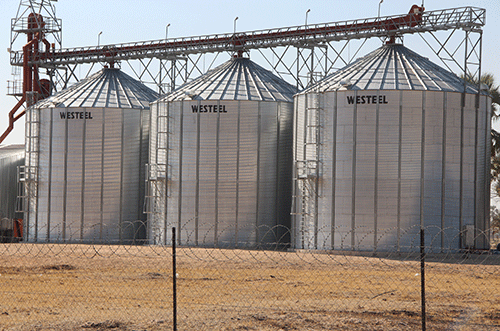Namibia’s strategic food reserves across the country are running dry at an alarming pace and on the verge of putting the country in an acute food shortage crisis at household and industrial levels.
In the latest Food Security and Drought Situation Report issued this week, the ministry of agriculture painted a gloomy picture of the country’s dwindling strategic food reserves and food sufficiency at the household level countrywide.
As things stand, the country’s strategic food reserve stocks are sitting at a worrying 16% of the total holding capacity of 22 900 metric tonnes of all the national reserves.
This figure consists of 1 110.52 metric tonnes of white maize at Katima Mulilo, 2 164.05 metric tonnes of white maize at Rundu and 484.40 metric tonnes of pearl millet at the Okongo silos, respectively.
Meanwhile, the Omuthiya and Tsandi silos are completely empty due to pearl millet sales to small-scale millers who do not have the capacity to import.
The report pointed out that much of the grains that could have been stored in the national silos are milled and distributed to needy people countrywide as part of the government’s ongoing drought relief food assistance programme.
Another reason contributing to declining stocks and poor intake of grains is the low production from local farmers, which is a result of the erratic and sporadic rainfall the country is experiencing.
Gloomy outlook
On the provisional crop estimates, the report indicates that many of the communal crop-producing regions are expecting below average harvest, following poor rainfall, coupled with prolonged and severe dry spells in early January, much of February and March.
This resulted in crop stress and mass wilting of crops during the critical stages of germination, flowering and grain formation, which will lead to poor crop harvest this season.
Maize production in the communal areas of the Zambezi, Kavango East and Kavango West regions is estimated at 3 400 metric tonnes, which is 50% below last season’s production of 6 800 metric tonnes.
In the commercial areas, maize production is provisionally estimated at 19 900 metric tonnes, again which is 77% lower than last season’s harvest of 88 200 metric tonnes.
Pearl millet production is estimated at 15 900 metric tonnes, and that is 22% lower than last season’s harvest of 20 500 metric tonnes.
Furthermore, sorghum production is estimated at 1 500 metric tonnes, reflecting a decrease of 32% from last season’s harvest of 2 200 metric tonnes.
The decrease in the expected harvest is highly attributed to the drought conditions and the prolonged dry spells experienced since last year.
On the other hand, wheat production in the commercial areas is estimated at 15 300 metric tonnes and that is 33% below last season’s harvest of 22 800 metric tonnes.
The decline in the expected wheat harvest from the commercial areas is primarily due to the substantial reduction in the numbers of farmers mainly from the private sector, most of which produce under rain-fed fields, leading to a further reduction in the total planted area.
Food security
Moreover, the report indicates that the household food security situation in southern, eastern, western and central parts of Namibia is also weakening due to the ongoing drought conditions.
Livestock farmers who depend on livestock farming for their sustenance predominantly inhabit these regions.
This poses a considerable challenge, as the pasture in these areas has been depleted and is insufficient to adequately support livestock.
A 2023 vulnerability assessment and analysis report on Namibia projected that about 695 000 people, which is 26% of the population, faced high levels of acute food insecurity between October 2023 and March 2024.
This situation required urgent action to reduce food gaps and protect the livelihoods of the most affected population.
The comprehensive nationwide drought humanitarian relief assistance food programme in all 14 regions has been ongoing since October last year and is set to end by 30 June 2024.
In addition to food assistance, the government is also implementing the Livestock Support Programme in all the regions to support mainly the livestock farmers.
The situation is dire across the country.
Late yesterday, the City of Windhoek’s latest dam level bulletin revealed a concerning situation for Windhoek, with the three main dams supplying water to the city reported to be at low levels.
Swakoppoort Dam, Von Bach Dam and Omatako Dam, which are crucial for the city’s water supply, show a combined volume of less than 50%.
Residents are encouraged to adopt water-saving measures, such as fixing leaks, using water-efficient fixtures and reducing non-essential water use.


